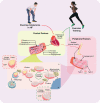Exercise: a molecular tool to boost muscle growth and mitochondrial performance in heart failure?
- PMID: 34957643
- PMCID: PMC9302125
- DOI: 10.1002/ejhf.2407
Exercise: a molecular tool to boost muscle growth and mitochondrial performance in heart failure?
Abstract
Impaired exercise capacity is the key symptom of heart failure (HF) and is associated with reduced quality of life and higher mortality rates. Unfortunately, current therapies, although generally lifesaving, have only small or marginal effects on exercise capacity. Specific strategies to alleviate exercise intolerance may improve quality of life, while possibly improving prognosis as well. There is overwhelming evidence that physical exercise improves performance in cardiac and skeletal muscles in health and disease. Unravelling the mechanistic underpinnings of exercise-induced improvements in muscle function could provide targets that will allow us to boost exercise performance in HF. With the current review we discuss: (i) recently discovered signalling pathways that govern physiological muscle growth as well as mitochondrial quality control mechanisms that underlie metabolic adaptations to exercise; (ii) the mechanistic underpinnings of exercise intolerance in HF and the benefits of exercise in HF patients on molecular, functional and prognostic levels; and (iii) potential molecular therapeutics to improve exercise performance in HF. We propose that novel molecular therapies to boost adaptive muscle growth and mitochondrial quality control in HF should always be combined with some form of exercise training.
Keywords: Cardiac and skeletal muscle; Exercise intolerance; Exercise training; Heart failure; Mitochondrial adaptation; Physiological muscle hypertrophy.
© 2021 The Authors. European Journal of Heart Failure published by John Wiley & Sons Ltd on behalf of European Society of Cardiology.
Figures



Comment in
-
Exercise intolerance in heart failure: beyond mitochondrial dysfunction. Letter regarding the article 'Exercise: a molecular tool to boost muscle growth and mitochondrial performance in heart failure?'.Eur J Heart Fail. 2022 May;24(5):910. doi: 10.1002/ejhf.2461. Epub 2022 Mar 9. Eur J Heart Fail. 2022. PMID: 35218105 No abstract available.
-
Reply to 'Exercise intolerance in heart failure: beyond mitochondrial dysfunction'. Letter regarding the article 'Exercise: a molecular tool to boost muscle growth and mitochondrial performance in heart failure?'.Eur J Heart Fail. 2022 May;24(5):910-911. doi: 10.1002/ejhf.2494. Epub 2022 Apr 3. Eur J Heart Fail. 2022. PMID: 35340090 No abstract available.
References
-
- Ponikowski P, Voors AA, Anker SD, Bueno H, Cleland JGF, Coats AJS, et al.; ESC Scientific Document Group . 2016 ESC Guidelines for the diagnosis and treatment of acute and chronic heart failure: The Task Force for the diagnosis and treatment of acute and chronic heart failure of the European Society of Cardiology (ESC). Developed with the special contribution of the Heart Failure Association (HFA) of the ESC. Eur J Heart Fail. 2016;18:891–975. - PubMed
-
- Reddy YNV, Rikhi A, Obokata M, Shah SJ, Lewis GD, AbouEzzedine OF, et al. Quality of life in heart failure with preserved ejection fraction: importance of obesity, functional capacity, and physical inactivity. Eur J Heart Fail. 2020;22:1009–18. - PubMed
-
- del Buono MG, Arena R, Borlaug BA, Carbone S, Canada JM, Kirkman DL, et al. Exercise intolerance in patients with heart failure: JACC state‐of‐the‐art review. J Am Coll Cardiol. 2019;73:2209–25. - PubMed
Publication types
MeSH terms
LinkOut - more resources
Full Text Sources
Medical
Research Materials
Miscellaneous

